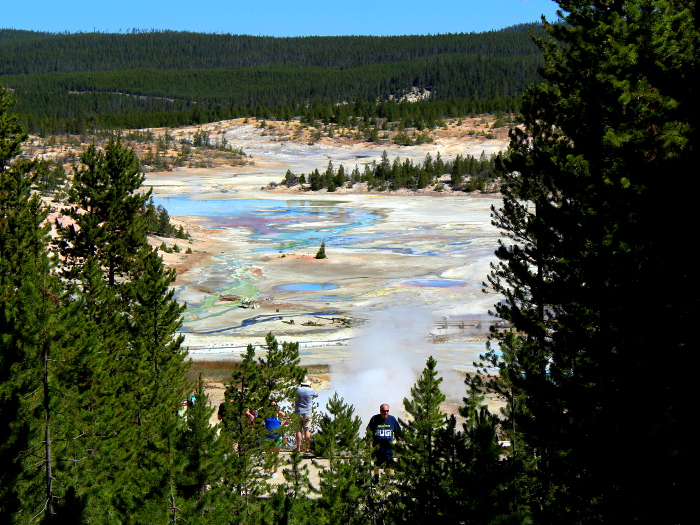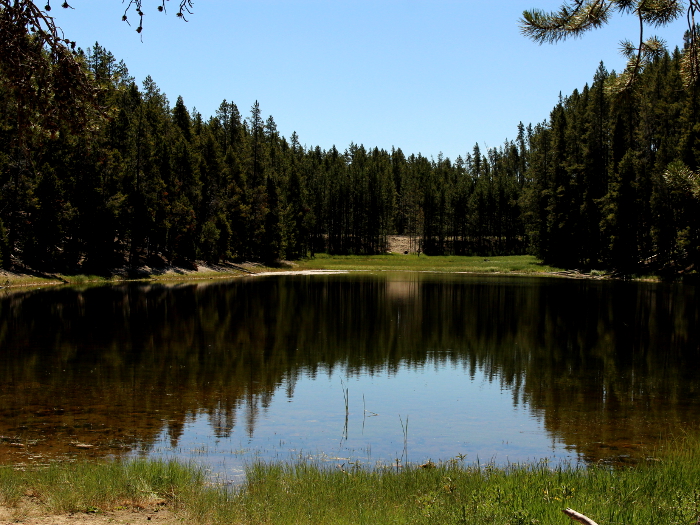A geyser is a vent on Earth's surface that periodically ejects a column of hot water and steam.
Geysers have eruptions that blast thousands of gallons of boiling hot water up to a few hundred feet
in the air. Norris Geyser Basin is one of the most extreme environment on earth. It is located near
the northwest edge of Yellowstone Caldera near the Norris Junction and on the intersection of three
major faults . ( A fault is a planar fracture or discontinuity in a volume of rock, across which there
has been significant displacement as a result of rock mass movement ).
Norris Basin is one of the most dynamic places in Yellowstone National Park. It comprises of three
Norris Basin is one of the most dynamic places in Yellowstone National Park. It comprises of three
main areas: Porcelain Basin, Back Basin, and One Hundred Springs Plain. Norris Geyser is named
after an Yellow Stone Superintendent and is the hottest geyser basin in Yellow Stone. It is difficult
for plants and animals to survive in such acidic environment. The basin is really colorful due to the
presence of many mineral oxides and bacteria known as thermophile . Many acidic pools seen here
are considered as the world's most oldest and hottest pools.
after an Yellow Stone Superintendent and is the hottest geyser basin in Yellow Stone. It is difficult
for plants and animals to survive in such acidic environment. The basin is really colorful due to the
presence of many mineral oxides and bacteria known as thermophile . Many acidic pools seen here
are considered as the world's most oldest and hottest pools.
Built in 1929 - 1930, the Norris Museum is situated on a hill between the Porcelain Basin and the
Back Basin of Norris Geyser Basin. The 94-foot (29 m) by 20-foot (6.1 m) museum consists of two
Back Basin of Norris Geyser Basin. The 94-foot (29 m) by 20-foot (6.1 m) museum consists of two
rectangular sections divided by the breezeway, which is roofed by a prominent jerkin head gable,
framed in massive logs. The pavilions to either side are of shingle-covered frame construction on a
massive stone base. A stone and concrete terrace surrounds the building.The museum exhibits focus
on geothermal geology, features of Norris Geyser and plant and animal life in thermal areas.
Norris Geyser Basin provides two easy ways to explore: the Porcelain Basin Trail and the
Steamboat/Echinus Geyser Trail. It provide a safe route for viewing the Porcelain Basin and Back
Basin. Porcelain Basin is open terrain with hundreds of densely packed geothermal features
while Back Basin is forested and its features are more scattered and isolated .
Steamboat/Echinus Geyser Trail. It provide a safe route for viewing the Porcelain Basin and Back
Basin. Porcelain Basin is open terrain with hundreds of densely packed geothermal features
while Back Basin is forested and its features are more scattered and isolated .
Porcelain Basin presents a beautiful but desolate visage which is unlike any of the other geyser
basins in Yellowstone . The name Porcelain basin was inspired by the milky color of the mineral
deposited here. The mineral, siliceous sinter also known as geyserite is brought to the surface by
hot water and forms a "sheet" over this flat area.
The landscape of Porcelain basin is stark and barren which is the result of acidic environment.
The basin is characterized by lack of vegetation. No plants can live in this hot, acidic, water
emitted from the numerous thermal features in the basin.
Porcelain Basin consist of Black Growler steam vent, Ledge Geyser, Congress Pool, Hot Springs,
Blue Geysers, Whirligig geyser, Colorful water, Whale's mouth and Crackling lake . The water in
Norris area is really acidic .The difference in pH allows for a different class of bacterial thermophiles
(bacteria) to live at Norris, creating different color patterns in and around the Norris Basin waters .
The Porcelain basin trail takes you to an incredible world of clear blue springs and passes through
a thin strand of trees and loops around . The blue pools are saturated with silica, which is the
primary component of glass. Norris's thermal waters contain the highest concentration of silica in Yellowstone.
a thin strand of trees and loops around . The blue pools are saturated with silica, which is the
primary component of glass. Norris's thermal waters contain the highest concentration of silica in Yellowstone.
Back basin is full of surprising sites, sounds and smells. It is alive with heats and gases from Yellow
Stone volcano beneath. With full of geysers and hot springs tucked among trees, Yellowstone
volcano is very much alive here. Back Basin is the lengthier trail at Norris Geyser Basin. It includes
Emerald Spring, Steamboat Geyser, Cistern Spring, Echinus Geyser, Green Dragon Spring,
Porkchop Geyser and Minute Geyser .
One of the notable attraction at Back Basin is Emerald Spring which is a clear blue pool. The water
here absorbs all other colors of sunlight except blue which is clear case of refraction. The 27-foot
(8 meter) deep pool is lined with yellow sulfur deposits. The yellow color from the sulfur combines
with the reflected blue light, making the hot spring appear a magnificent emerald green.


The largest geyser in the world steam boat geyser is also located at Back basin. When it erupts the
water jet reaches a height of 380 ft in a spectacular display. Steamboat has an erratic and lengthy
timetable between major eruptions.Steamboat erupts over 300 feet (90 m) into the air. It does not lie
dormant between eruptions, instead display minor eruptions of approximately 40 feet (12 m).
Cistern Spring and Steamboat Geyser are linked underground. During a major eruption of Steamboat,
water jet reaches a height of 380 ft in a spectacular display. Steamboat has an erratic and lengthy
timetable between major eruptions.Steamboat erupts over 300 feet (90 m) into the air. It does not lie
dormant between eruptions, instead display minor eruptions of approximately 40 feet (12 m).
Cistern Spring and Steamboat Geyser are linked underground. During a major eruption of Steamboat,
the water in Cistern Spring's pool drains. Normally, Cistern is a beautiful blue pool from which water
continually overflows. Cisterns spring's brown, green and orange color represents species of visible algae and bacteria.

The Ragged Hills that lie between Back Basin and One Hundred Springs Plain are thermally altered
glacial kames.The hottest of Yellowstone's geothermal features are steam vents (fumaroles). Sulfuric
acid, steam and gases escape through vents in ground which create a barren and unsafe ground called
Solfatara. Here scalding mud and steam are barely covered by hot crumbling decomposing rock.


The Ragged Hills that lie between Back Basin and One Hundred Springs Plain are thermally altered
glacial kames.The hottest of Yellowstone's geothermal features are steam vents (fumaroles). Sulfuric
acid, steam and gases escape through vents in ground which create a barren and unsafe ground called
Solfatara. Here scalding mud and steam are barely covered by hot crumbling decomposing rock.

One hundred spring Plain is an off-trail section of Norris Geyser Basin. It is flat,
sandy, and extremely dangerous.Much of the underlying ground is hollow and many of the thermal
features are acidic. Most of the hot springs in this area have never been named. Cinder Pool, once
called Verma Spring, is a remote and isolated feature on the One hundred Spring Plain.
Nuphar Lake is situated along the trail between Porcelain Basin and Norris Campground. There is
another lake called Crackling lake can be found at Norris Basin.The name of this thermal feature was
proposed by Ed Leigh in 1967 because of popping sounds from nearby springs on its southern shore.

Nuphar Lake is situated along the trail between Porcelain Basin and Norris Campground. There is
another lake called Crackling lake can be found at Norris Basin.The name of this thermal feature was
proposed by Ed Leigh in 1967 because of popping sounds from nearby springs on its southern shore.

North of Norris is Roaring Mountain. It is a large, acidic hydro thermal area (solfatara) with many
fumaroles. In the late 19th and early 20th centuries, the number, size, and power of the fumaroles
were much greater than today. The fumaroles are most easily seen in the cooler, low-light conditions
of morning and evening.



Artist Paint Pot is located at Madison at a distance of 4.4 miles south of Norris Basin. It is on the
midway between Old Faithful and the Norris Geyser basin. This small hydro thermal area offers an
array of thermal features including colorful hot springs and two large mud pots.
midway between Old Faithful and the Norris Geyser basin. This small hydro thermal area offers an
array of thermal features including colorful hot springs and two large mud pots.

A one-mile round trip trail through Artist's Paint Pot took visitors through a section of forest burned
in 1988. The Artist's Paint Pots trail is so full of vibrant colors, comparable only to an artist's palette.
Adjacent to this area are three other off-trail, back country thermal areas: Sylvan Springs, Gibbon
Hill Geyser Basin, and Geyser Creek.

Rainbow colors, hissing steam, and pungent odors greet your senses at Norris Basin. These thermal
areas pulsates from steam and boiling water beneath the surface a feature which appear and
disappear often . Many of the remote areas at Norris Basin are fragile, dangerous,and difficult.
Traveling to remote areas in thermal areas without the aid of knowledgeable personnel is discouraged.
in 1988. The Artist's Paint Pots trail is so full of vibrant colors, comparable only to an artist's palette.
Adjacent to this area are three other off-trail, back country thermal areas: Sylvan Springs, Gibbon
Hill Geyser Basin, and Geyser Creek.

Rainbow colors, hissing steam, and pungent odors greet your senses at Norris Basin. These thermal
areas pulsates from steam and boiling water beneath the surface a feature which appear and
disappear often . Many of the remote areas at Norris Basin are fragile, dangerous,and difficult.
Traveling to remote areas in thermal areas without the aid of knowledgeable personnel is discouraged.
Location: Yellowstone National Park, Wyoming
Managed by National Park Service,
Phone: (307) 344-7381
Camera Used: Canon EOS rebel
Warning about GPS Systems! Vehicle Navigation Systems and GPS units may provide inaccurate information—sending drivers the wrong way on one-way roads, leading them to dead ends in remote areas, or sending them on roads which are closed at certain times of year. Make sure to use park road maps available at entrance stations.
Trailhead address: Grand Loop Road & Norris Canyon Road, Yellowstone National Park, WY 82190
Trailhead address: Grand Loop Road & Norris Canyon Road, Yellowstone National Park, WY 82190
.











No comments:
Post a Comment